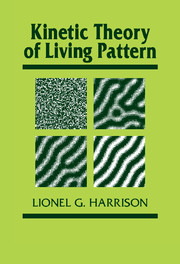Book contents
- Frontmatter
- Contents
- Preface
- Part I Macroscopics without mathematics
- 1 Introduction
- 2 Morphogen: one word for at least two concepts
- 3 Pictorial reasoning in kinetic theory of pattern and form
- 4 Structure, equilibrium, kinetics
- Part II Pattern-forming processes
- Part III Bringing experiment and theory together
- References
- Index
3 - Pictorial reasoning in kinetic theory of pattern and form
Published online by Cambridge University Press: 22 September 2009
- Frontmatter
- Contents
- Preface
- Part I Macroscopics without mathematics
- 1 Introduction
- 2 Morphogen: one word for at least two concepts
- 3 Pictorial reasoning in kinetic theory of pattern and form
- 4 Structure, equilibrium, kinetics
- Part II Pattern-forming processes
- Part III Bringing experiment and theory together
- References
- Index
Summary
Practitioners of reaction-diffusion theory are frequently presented – off the cuff, in some informal discussion – with some example of morphogenesis and asked whether that type of theory can explain it. On an epithelial sheet, can it account for the arrangement of feather follicles, or bristles, or whatever, in a regular hexagonal array? Can it account for periodically repeated structures only 1–2 μm apart, such as xylem rings? Can it account for instances of unequal division of plant cells? If so, what about the more numerous instances of unequal division? Can it account for morphallactic regulation, in which a chopped-off piece reproduces in miniature the former pattern of the whole, as in the differentiation of a slime-mould slug? If so, what about epimorphic regulation, in which a structure with a piece removed grows out to restore it, as in many phenomena of insect development.
(This last question is very important and can be expressed much less polysyllabically: Can reaction-diffusion both measure and count? Experimentally, both clearly happen, even in normal development. The whorls of hairs produced by the alga Acetabularia have variable numbers of hairs, but constant spacing between adjacent hairs: Morphogenesis measures. The cellular blastoderm of Drosophila always has 14 parasegments in normal development, though the length of the egg can vary by at least 30%: Morphogenesis counts.
- Type
- Chapter
- Information
- Kinetic Theory of Living Pattern , pp. 56 - 88Publisher: Cambridge University PressPrint publication year: 1993



